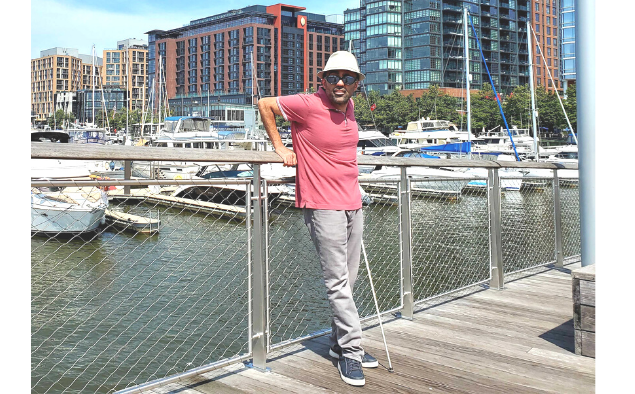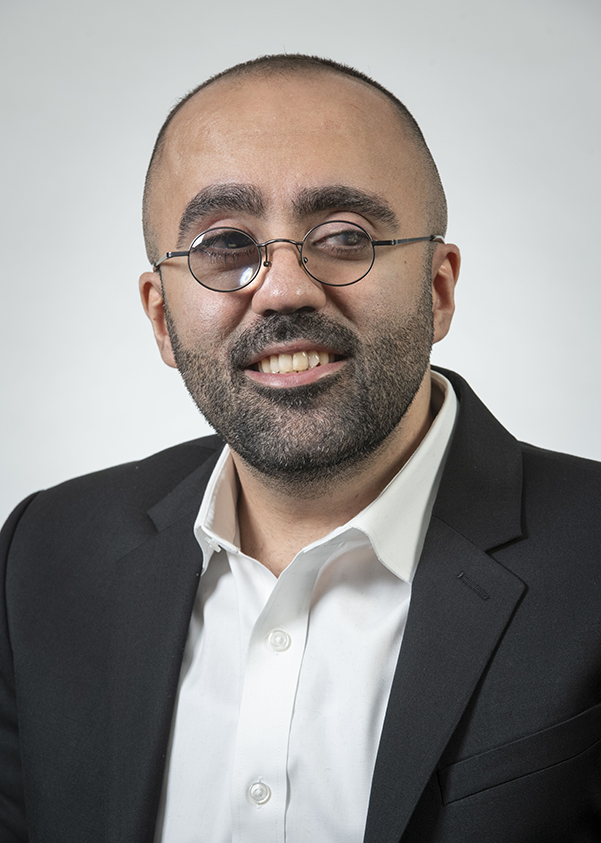Editor’s note: In the United States, October 15 is celebrated as White Cane Awareness Day — originally established as White Cane Safety Day by President Lyndon B. Johnson in 1964. White canes are a powerful mobility tool and symbol of independence for people who are blind, deafblind, or have low vision. In 2011, President Barack Obama also referred to White Cane Safety Day as Blind Americans Equality Day. In honor of White Cane Awareness Day, Amir Rahimi, AFB’s Major Donor and Corporate Relations Specialist, shared how he first came to embrace using a white cane.
I lost my vision abruptly in 2009 as a result of an accident. I was getting ready to go out and I bent down to grab something in my room. I was rushing, and my right eye collided with the edge of a box on the floor. I injured my cornea, went to the doctor and they surgically repaired it, but then I began developing retinal detachments, which resulted in me losing most of my vision.
I spent the next two years very depressed. I was not accepting that I was blind. A lot of people who experience an abrupt loss of vision go through this. I had a little bit of vision, which gets you in trouble, right? You try to pretend like you’re sighted. I was depending on others to get me rides, holding onto their elbow, and following them around. I didn’t want to learn how to use a cane. I didn’t want to learn how to use assistive technology. I didn’t even know about it, honestly.
Later on, someone put me in touch with a blind mentor who told me about resources available to blind people, like getting orientation and mobility (O&M) instruction, assistive technology, and much more. The first time I was introduced to a cane was in 2011. I signed up for an O&M instructor to come work with me, Mary Beth Lambert, and she gave me my first white cane. We started in the house.
I had so much insecurity in the beginning. I was really ashamed of holding a cane. She said, “Let’s start with learning how to hold a cane in your house. We’ll play around with it and learn some techniques.”
And then it was, “OK, let’s go in your front yard.”
Then, “Let’s walk around in your neighborhood.”
And I thought to myself, “Oh my god, everyone’s going to see me holding this cane.” When you’re newly blind and struggling, you think everybody’s looking at you. But I forced myself to go and walk in the neighborhood, and it wasn’t so bad.
“Now we’re going to learn to go and walk around in the mall.”
And I’m thinking, Oh, my god, my friends are going to see me!
But slowly, we kept doing bigger and bigger things. Taking the metro, the bus, going places. She would give me an assignment, “I want you to go to so-and-so.”
Even after I got more skillful at using the cane, I was very insecure about it. When my friends would come over to go out, I wouldn’t use my cane. I would just follow them around and stay really close to them. But that would get me into trouble — I would fall, run into stuff.
I told Mary Beth about this. And she suggested that I tell one friend: let’s go out, I want to practice using my cane with you. So I did. I asked my best friend Kasra.
But at the last second, when he pulled up, I said to myself, Forget it, I’m leaving my cane in the house.
As I got in the car, Kasra immediately said, “Where’s your cane?”
And I said, “Ah, I don’t need it, I’m good.”
And Kasra said, “Amir, you’re such a disappointment right now. Go get your cane or we’re not hanging out.”
I thought about it for a second, got out of the car, and got my cane.
When I came back, Kasra said, “Dude, I don’t care if you have a cane on you, I just want you to live a good life and be independent.”
And it made sense to me. Like, why do I care so much about this?

Then I started using my cane more frequently. I’ve always been an extrovert, so I started using it with different friend groups, and the more I used it, the more I got used to taking it with me. For a while, half the time I would take it, half the time I would leave it.
Not too long after, I decided to enroll in a one-year sleep shade training program in Baltimore with Blind Industries and Services of Maryland to improve on my travel skills and learn to be more independent.
I was always so afraid when I was crossing the street, especially at an intersection with lights. My instructor told me, “Walk boldly. Stick your chest out, put your chin up, and walk boldly. Trust yourself, trust your cane, listen for the signals, and then just go for it.”
To graduate from the program, I had to go to another city on my own, so I decided to check out Miami. I was very nervous at first, but it ended up being an amazing experience. I stayed at a hostel, and wound up meeting all these people from around the world—Germany, South America—and navigating a new city totally on my own with the cane.
My teacher had homework for me. He would give me an address and ask me to go find it. And it would be a museum, or the Miami Lighthouse for the Blind. I was hanging out with people from the hostel one night, and they were asking me how I got around. I started giving them O&M instructions on how to use a cane, how to tap it, how to find different things as you’re walking, and how to cross a street. I remember thinking, Wow, this is pretty cool, how much I’ve learned. I even gave one of them my sleep shades and let them give it a try.
A while after graduating from the program, I was going out the door with my cane in my hand. And I’m thinking to myself, it’s pretty awesome that there was a time when I was so ashamed of carrying this cane, and I used to leave it in the house a lot of the time. I don’t even think about it anymore. It’s just like grabbing my shoes or keys as I go out the door. It has become second nature to have it, it’s a part of me now. I’m very proud of it, and I’m not ashamed of having a disability or being blind.
As my instructor had once suggested, I “walk boldly.”
I see a lot of people who are younger, or who still have some residual vision, struggling with this. Not having a cane on them because they’re insecure. It’s something that’s not discussed enough, but I think it’s important for people to become aware of it, and empathize. I definitely relate to that fear.
It’s okay to have anxiety or fear about using a cane. But, the only way to get over any fear is to confront it. The more you use your cane, and you go out with it, the more you’ll go against that fear and anxiety, and the more comfortable you’ll become. If you really want to be comfortable with your blindness, you have to get comfortable with these techniques. It will answer those doubts in the back of your head: Am I really good enough to do this? Because you will know that you are, and you can. It’s going to serve you in the long run.
